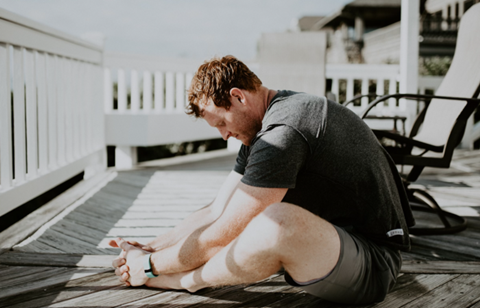
At Myles Wellbeing, we believe in making employee physical wellbeing simple. A great way to improve wellbeing is through physical activity: exercise helps make happier and healthier employees as from increasing energy levels to reducing stress, the benefits of physical activity are numerous.
In particular, by exercising, your improvement in physical wellbeing will intrinsically link to an improvement in work performance. Having a higher work performance or productivity is great, but what’s better is the fact that you can exercise, and thus improve your work rate, actually at work!
The NHS recommends that adults do at least 150 minutes of moderate intensity activity a week or 75 minutes of vigorous intensity activity a week. If we break this down, the NHS advises that you do around 20 minutes of exercise every day. A great time to do 20 minutes of exercises is at your desk, so here’s 10 exercises you can try out when you’re next working.
1. Desk pushups
Before you start exercising, please make sure your desk is sturdy enough to support your body weight! If you’ve got the go ahead, take a couple of steps back and place your hands flat on your desk and keep your arms straight. Lower yourself towards your desk, until your chest almost reaches your desk. Keep your core tight and push back, returning to your start position. This exercise will work your triceps and chest muscles, so try at least 10 reps!2. Desk plank
Still using your desk, try out a plank to work your core and shoulder muscles. Simply lean against your desk, making sure you keep your body in a straight line as well as your elbows and forearms against your desk and your hands together. Try and hold this position for at least 30 seconds, but the longer the better!3. Wall sits
For the lower body, try wall sits. This is where you hold you back against a wall until your hips and knees are making a 90-degree angle. Try to maintain the position for 30-60 seconds, then release and repeat.4. Lunges
Another easy but effective exercise to do at your desk are lunges. Start by standing tall, with good posture and your hands on your hips for balance. Step forward by placing one leg in front of the other, and then gently lower the knee of your back leg down towards the ground. Make sure you keep your bent knee in line with your toe, and then step back to the starting position. This exercise works your core, quads and hamstring muscles, so try 10 to 20 reps on each leg.5. Jumping jacks
According to GOV.UK, around one in three (34 percent) of men and one in two (42 percent) of women are not active enough for good health. Concerns can therefore arise with NHS statistics showing how 10,780 hospital admissions are directly attributable to obesity.A really easy full body exercise is jumping jacks. All you have to do is stand with your arms by your sides and your feet shoulder-width apart. Then jump up, reliving your childhood, and land with your feet wider and your hands over your head. Continue this process, returning to your start position, for 15 reps.
6. Oblique twists
If you would rather work out your core at work and have a swivel chair, oblique twists may be for you. Sit straight and hover your feet above the floor while holding onto the edge of your desk. Then, engage your core by swivelling the chair from side to side, going back and forth for 15 times.7. Bicep Curls
Another easy way to exercise at work is through weights, which are great for building muscle. A simple weight exercise for your arms are bicep curls. To do this, choose a weight or dumbbell which you can lift with some resistance. Then, stand tall and place the dumbbell in one hand and have your arm straight by your side. Crucially, without shifting your weight, bend your elbow as you curl the dumbbell up towards your shoulder. At the top of the movement, pause to feel some pressure (gains!) and then lower to the starting position. Repeat this for at least 10 reps, then switch to the other side.8. Front raises
To exercise your shoulder muscles with weights, try out front raises. Do note, if you don't have weights you can use a heavy object, such as full water bottles, for the same exercises but they may be less effective.For this exercise, again, stand tall, with a dumbbell in your hand and keep your arm by your side. Have your palm facing toward you and lift the weight in front of you, keeping your arm straight. Stop raising your arm when it is parallel with the ground, and pause in this position. Lower your arm after and repeat the exercise for at least 10 reps, then switch sides.
9. Squats
If you don’t have weights, a cheaper alternative for additional gains is using a resistance band. These bands are particularly useful with squats, but you can also squat with no band.All you have to do is stand up from your chair, keeping your feet shoulder-width apart. Lower your body back down, stopping right before you sit back down and make sure you keep your knees in line with your toes. Return to your starting position and repeat for 15 reps.











